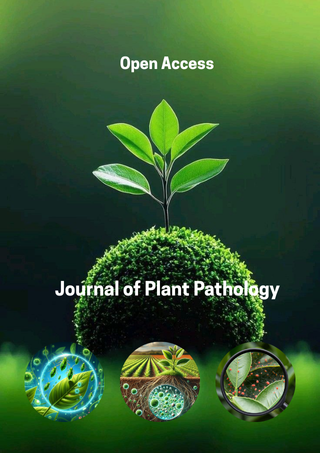Indexed In
Journal Flyer

Journal Highlights
Useful Links
Recommended Journals
Open Access Journals
ABSTRACT
Plants are constantly exposed to a myriad of pathogenic organisms, yet they have evolved sophisticated defense mechanisms to survive in a pathogen-rich environment. This review synthesizes current understanding of plant defense strategies, highlighting the interplay between structural barriers, biochemical compounds, and molecular signaling networks. The discussion includes classical defense responses such as lignification and phytoalexin production, as well as modern insights into PAMP-triggered immunity (PTI) and effector-triggered immunity (ETI). The review further explores how hormonal pathways and epigenetic regulation contribute to plant resilience, with implications for crop improvement and sustainable agriculture. Keywords: Plant immunity; PAMP-triggered immunity; Effector-triggered immunity; Phytoalexins; PR proteins; Systemic acquired resistance; Epigenetics; CRISPR; Plant-pathogen interaction; Hormonal crosstalk.
INTRODUCTION
Plants lack mobile immune cells and must rely on innate, cellautonomous defenses to protect against pathogens. These defenses are broadly categorized into constitutive (preformed) and inducible responses. While the former includes physical barriers like cuticles and cell walls, the latter involves dynamic biochemical and molecular responses triggered upon pathogen detection. The increasing understanding of these defense mechanisms provides essential tools for developing diseaseresistant crops through biotechnology and breeding programs.
table1
Table 1: Types of Plant Defense Mechanisms
Structural and Physical Barriers
The outermost layer of the plant body, the cuticle, acts as the first line of defense against microbial invasion. Its hydrophobic nature deters waterborne pathogens and limits spore adhesion. Cell Wall Fortification In response to attack, plants reinforce their cell walls through callose deposition, lignification, and cross-linking of glycoproteins, forming a mechanical shield to restrict pathogen entry.
Biochemical Defense Responses
Upon recognition of pathogens, plants rapidly generate ROS such as superoxide and hydrogen peroxide. These molecules function in both direct antimicrobial activity and as signaling intermediates in defense pathways.
table2
Table 2: Table: Key Compounds and Pathways Involved in Plant Defense Mechanisms
Phytoalexins and Antimicrobial Peptides Phytoalexins are low molecular weight secondary metabolites synthesized de novo in response to infection. Examples include camalexin in Arabidopsis and resveratrol in grapes. Plants also produce defensins and thionins, which disrupt microbial membranes. Pathogenesis-Related (PR) Proteins These include chitinases, glucanases, and peroxidases that degrade pathogen cell walls and accumulate in infected tissues.
Molecular Signaling and Inducible Immunity
Pattern Recognition Receptors (PRRs) and PTI Plants detect pathogen-associated molecular patterns (PAMPs) through PRRs located on the plasma membrane, initiating PAMP-triggered immunity (PTI). PTI activates a cascade of defenses including MAPK signaling, transcriptional reprogramming, and callose deposition. Effector-Triggered Immunity (ETI) To overcome PTI, pathogens deliver effectors into plant cells. In turn, plants have evolved resistance (R) genes encoding nucleotide-binding leucine-rich repeat (NLR) proteins to detect effectors and trigger ETI, which is often associated with the hypersensitive response (HR).
Hormonal Crosstalk in Plant Immunity
Defense responses are modulated by phytohormones including: Salicylic acid (SA): Key in resistance against biotrophic pathogens. Jasmonic acid (JA) and ethylene (ET): Crucial against necrotrophic pathogens and herbivorous insects.Abscisic acid (ABA): Can act as a negative regulator, often exploited by pathogens. The SA-JA-ET axis represents a finely tuned balance determining the specificity and intensity of immune responses.
Epigenetic and Transgenerational Defense
Recent studies suggest that histone modifications, DNA methylation, and small RNAs play a critical role in priming plants for enhanced immunity. These changes can persist, leading to transgenerational immune memory, a phenomenon with implications for breeding stress-resilient cultivars.
Systemic Acquired Resistance (SAR) and Induced Systemic Resistance (ISR)
SAR is activated by local infection and leads to long-lasting defense throughout the plant, largely mediated by salicylic acid and PR proteins. ISR is triggered by beneficial microbes like Pseudomonas fluorescens and relies on JA and ET signaling, offering broadspectrum resistance without a visible HR.
Biotechnological Applications and Future Directions
Advances in CRISPR-Cas’s genome editing and omics technologies have accelerated the discovery and manipulation of plant immune components. Future research is expected to focus on: Engineering broad-spectrum resistance without yield penalties Stacking R genes for durable resistance Deciphering the plant microbiome's role in immunity.
CONCLUSION
Plant defense is a multi-layered system involving intricate structural, chemical, and genetic networks. Understanding these mechanisms not only unveils the complexity of plant-microbe interactions but also provides sustainable solutions for crop protection in the face of climate change and evolving pathogens.
